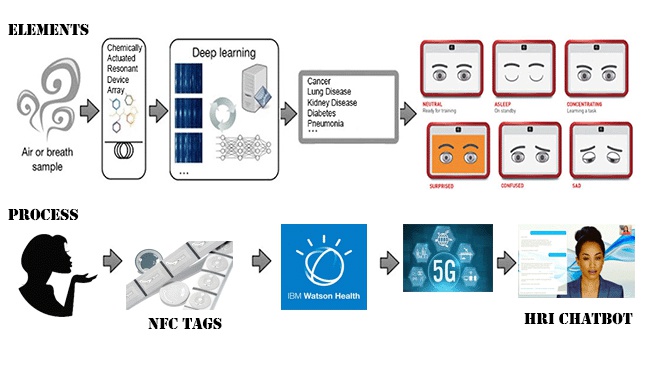
Project Concept: Curbside Telehealth 5G Small Cell Mounted Kiosk
The Goals of The Corner Body Owner Interface (CornerBOI) are to simultaneously:
Problem Statement: We have observed that local government has not been unable to reduce the cost of health insurance for a citizen. This is due in part to the use of emergency care (ER) by indigent communities as primary care. This use of the ER has created a negative impact on the cost of health care for taxpayers. These costs are seen in higher health insurance cost for citizens and reduced face to face interaction time with primary care doctors.
Ideation: How might we improve the health of lower-income and indigent communities, by using technologies that create an experience where care is instant, convenient, and provides minimal primary healthcare to citizen; while lowering the cost of healthcare for the general public, and financial impacts to the federal taxpayer.
Solution Concept: The Corner BOI will use AI to both simplify the user experience with a Human-Robot Interface (HRI) enabling access to the care on demand; providing 24/7 monitoring of user care concerns in real-time; preserving key health data to improve the health of the user community; improve the training of a health AI algorithm by providing a wider range of health data; and reducing data bias by providing data from a wider community.
The user experience is simple. Approach a light pole or a 5G small cell tower with a corner BOI telehealth kiosk. Look up and be welcomed by an (HRI)Avatar. The User uses speech to interact, and the HRI leads the user in a few diagnostic tests. That data is transmitted to a VOC’s E-Nose NFC CARD for analysis. That data is stored and transmitted to a cloud-based AI that identifies Bio-Markers in the breath that is related to specific disease and then use Predictive Analytics…to analyze the data and the Data is store for training an Artificial Neural Network (ANN).
We focused on the homeless community for a test bed. Based on interviews identified three areas of concern, Housing, Healthcare, and Jobs. The range of health problems in the homeless and indigent communities are large due to issues like drug and alcohol abuse, exposure, poor diets. When looking at their “Journey” we noticed a lot of pressure is added to existing healthcare systems like public health clinics and ER’s. Appointment waits can be several weeks long at clinics, and ER’s are stressed to their limit with indigent care… the cost impacts on Medicaid add up to more than $16 billion dollars per year to tax-payers. 44000 citizens Die Each Year Because They Cannot Afford Healthcare.
The Cost of the Uninsured Citizens is more than $30 Billion in the US. Our goal “improve the Convenience, Cost and Quality of this community’s health experience while lowering the cost impacts on government” and improving the customer’s healthcare Journey.
A 2011 study by Anna Sommers and Peter Cunningham released by the National Institute for Health Care Reform found that hospital re-admissions within a month of discharge have cost over $16 billion each year. Telehealth can be used to reduce re-admissions and other adverse events at a cost that is less than the cost of the problems themselves”.
There is a potential for $billions in savings to the taxpayer that can be used to lower the cost of health insurance for all. We believe our path to financial success starts with obtaining grants to pilot prototypes, partnerships with local city governments, pharma, and then raise capital through VC's.
An initial interaction with the CornerBOI Avatar Interface would include the collection of some background info like this.
The next question might be, what about the HIPAA privacy concerns?
We also believe that there is an opportunity here for the users to take ownership of their data. We’ve created User Privacy Fact sheet. The User Privacy Fact sheet … lays out how users and the city could be compensated…by selling different types of biometric data…. using a Life Data Marketplace, and a cryptocurrency. A life data marketplace aims to facilitate the sale/purchase of human data between the General Public and Pharmaceutical companies.
When we became ill and needed medical attention, we go to a doctor or hospital. For the homeless, and some lower income residents being ill can be challenging and m ore than just financially disruptive it can be devastating. With the advent of telehealth we could receive care at churches soup kitchens, food banks or even the curbside small cell tower. at almost no cost to the user and very little to the taxpayer. AI could make recommendations after a short interaction with an avatar, and even potentially submit prescription requests.
However, this remote monitoring, along with sophisticated analytical equipment, can lead to additional strain on the networks of the healthcare industry. This often increases congestion and slows network speeds, especially for health neural networks that might be interfacing with dozens of patients a day. The lag is not only frustrating for those using it, but the poor quality can delay patient care, which could hurt outcomes in the long run. And because the use of Internet of Things (IoT) technologies continue to grow, the amount of data on networks is expected to only increase more. 5G technologies have the potential to help resolve these challenges. Here are few ways 5G can help healthcare organizations meet the growing demands of digital transformation: